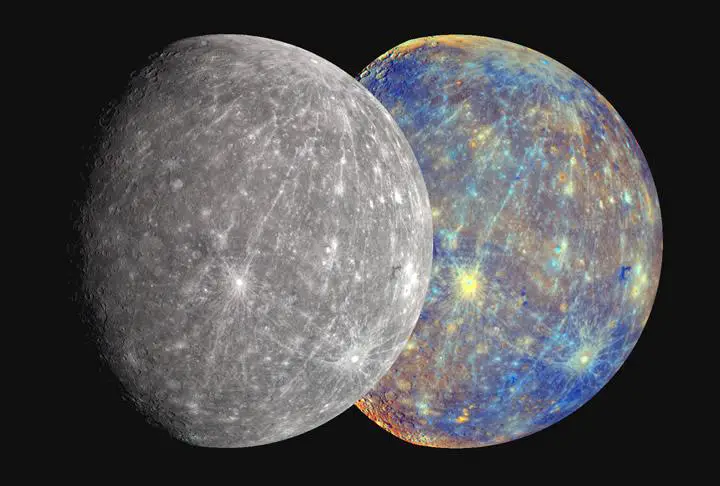Introduction
Mercury is the smallest planet in our solar system and is located closest to the sun.
Despite its small size, it plays a significant role in our understanding of the solar system.
Studying Mercury can provide insights into the formation and evolution of the solar system, as well as the geology and atmosphere of rocky planets.
In this article, we will explore the physical characteristics, orbit and rotation, atmosphere, geology, magnetic field, and exploration of Mercury, as well as its importance in understanding the solar system.

Mercury in Color!
The Physical Characteristics of Mercury
Mercury has a diameter of 4,880 kilometers, making it the smallest planet in the solar system.
It has a mass of 3.3 x 10^23 kilograms and a density of 5.427 grams per cubic centimeter, which is similar to Earth’s density.
Mercury’s surface temperature can reach up to 800 degrees Fahrenheit during the day and drop to -290 degrees Fahrenheit at night. The planet’s surface is composed of rocky material, with a high concentration of iron.
It is also covered in craters, cliffs, and other surface features, which we will explore in more detail in the next section.
The Orbit and Rotation of Mercury
Mercury has an eccentric orbit, which means that it is not a perfect circle. Its orbit takes 88 Earth days to complete, and it rotates on its axis once every 59 Earth days.
This rotation pattern is unique among the planets in our solar system. Mercury’s orbit is also in a “3:2 resonance” with the sun, which means that it completes three rotations on its axis for every two orbits around the sun.
This resonance is caused by the gravitational pull of the sun and is a rare phenomenon in the solar system.
The Atmosphere of Mercury
Mercury has a thin and tenuous atmosphere, known as an exosphere. The exosphere is composed of atoms and molecules that have been stripped of their electrons by the solar wind.
The composition of the exosphere is primarily made up of helium, hydrogen, and oxygen.
The dynamics of the exosphere are influenced by the planet’s magnetic field, which we will explore in more detail in the next section.

The Geology of Mercury
Mercury’s surface is surprisingly diverse, with a range of features including craters, cliffs, and volcanic plains.
The planet’s surface is heavily cratered, indicating that it has been bombarded by asteroids and comets throughout its history.
The cliffs on Mercury, known as scarps, are some of the largest in the solar system and are thought to be caused by the planet’s cooling and shrinking over time. Mercury also has evidence of volcanic activity, with large plains of smooth, volcanic rock covering parts of the planet’s surface. The planet’s tectonic activity is also unique, with evidence of thrust faults and compressional features.
Comparing Mercury’s geology to other rocky planets in the solar system can provide insights into the formation and evolution of these planets.
The Magnetic Field of Mercury
Mercury has a puzzling and evolving magnetic field. Unlike Earth’s magnetic field, which is generated by the planet’s core, Mercury’s magnetic field is thought to be generated by its partially molten outer core.
The magnetic field is also influenced by the planet’s rotation and the solar wind.
The magnetic field is important in understanding the dynamics of the exosphere and the planet’s geology.

The Exploration of Mercury
Mercury has been explored by several missions, including Mariner 10, Messenger, and BepiColombo. Mariner 10 was the first mission to visit Mercury in 1974, and it provided the first close-up images of the planet’s surface.
Messenger, which orbited Mercury from 2011 to 2015, provided detailed information about the planet’s geology, atmosphere, and magnetic field.
BepiColombo, a joint mission between the European Space Agency and the Japan Aerospace Exploration Agency, launched in 2018 and is expected to arrive at Mercury in 2025.
These missions have provided significant advancements in our understanding of Mercury and its role in the solar system.
The Importance of Mercury in Understanding the Solar System
Mercury is a key piece of the puzzle in understanding the formation and evolution of the solar system. Studying Mercury can provide insights into the processes that shaped the rocky planets, as well as the role of the sun in the formation of the solar system.
Comparing Mercury to other planets and asteroids can also provide insights into the diversity of the solar system.
The Potential for Future Research on Mercury
There is still much to uncover about Mercury, and future missions and advancements in technology can provide even more insights into the planet.
Possible future missions include landers and rovers that can explore the planet’s surface in more detail, as well as missions that can study the planet’s interior and magnetic field.
As stated earlier the BepiColombo mission will hopefully arrive at the planet in 2025 and we hope that it will provide more information on Mercury
Conclusion
Mercury may be the smallest planet in the solar system, but it plays a significant role in our understanding of the solar system and beyond.
Its physical characteristics, orbit and rotation, atmosphere, geology, magnetic field, and exploration have provided significant advancements in our understanding of the planet and its role in the solar system.
Continued research on Mercury and other planets in the solar system can provide even more insights into the formation and evolution of our cosmic neighborhood.
Links
We have facts about Mercury here – Mercury facts
The stunning images are from – https://images.nasa.gov/
